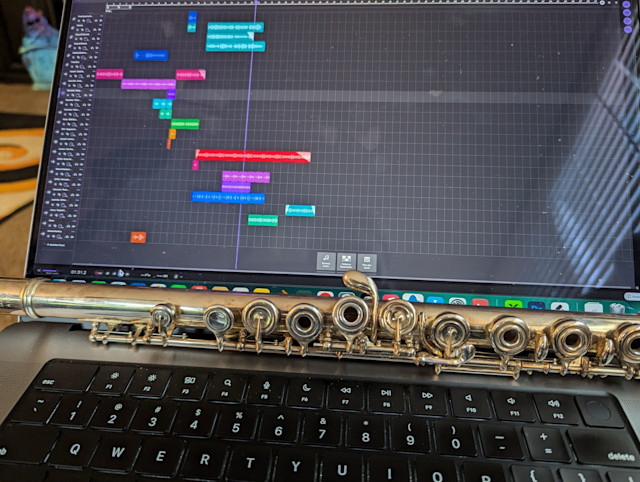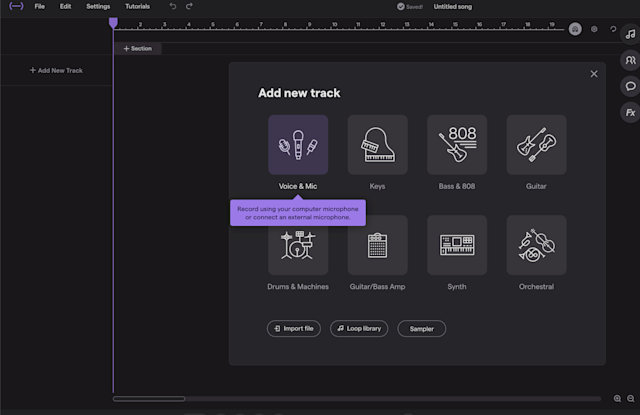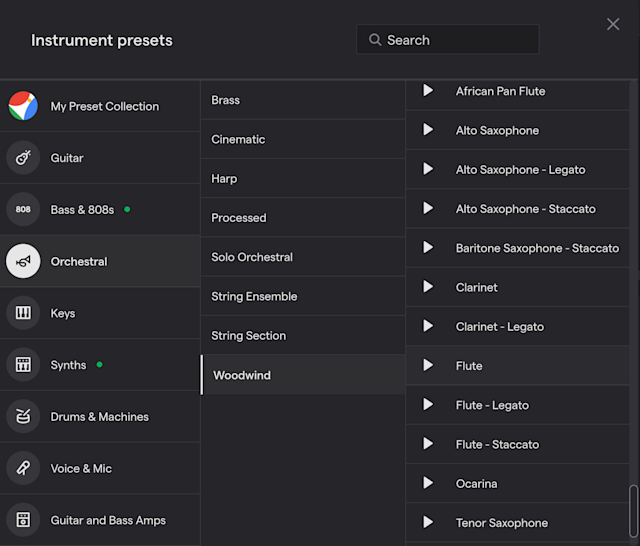Recording Woodwinds in Soundtrap
September 27, 2024 - Are you an instrumentalist looking to mix things up? Here are some tips, tricks, and ideas for how to record your woodwinds in Soundtrap.

Mixing Up Woodwinds
I’m a classically trained flutist. But sometimes, playing Haydn just doesn’t make me happy. I mean, it can, but other times, I feel worn out and uninspired by ‘playing by the rules’. I wanted a way to play my main instruments (woodwinds) but make it fun and freeing.
Enter: Soundtrap.
If you’re also looking to record your woodwinds in a refreshing way, keep reading! In this article, I will give you a few tips and tricks for each instrument, as well as some creative ideas to help get you started.
Can You Turn Mozart into a Beat?
Before we dive in deeper I’d like to share a bit more of my experience. One day, I was attending a local classical concert. I spotted one of my ex-profs and felt my mind be transported to the past. Sometimes, classical lessons and practices put pressure on your art, and that turns into a diamond. Other times, it just crushes you. The quotes from various profs flooded my mind “Don’t write in your music if your handwriting is going to look like that” and “Your compositions don’t sound anything like any of the composers you like, and we should throw this entire piece out!”
The symphony droned on, and honestly? It was way out of tune. I felt my focus and patience for the piece fade around the edges until I decided that I was going to make something when I got home. Something that some of those professors would absolutely hate. I chose a boom-bap backdrop, added orchestral hits, and then put the melody line to a Mozart tune up top. I called it “The Magic Flute: Beatified”.
Despite it being just a minute-long, it ended up being my second most popular track.
So, if you’re a woodwind player like me who is looking to mix things up and make some waves…then let’s go!
And even if you don’t play, if you want to make a woodwind loop to sound richer and fuller in your mix, stay with me.
Here is a guide to recording and editing woodwinds through the lens of Soundtrap.
Gett Creative with Soundtrap’s Effects
Chorus
Excessive pre-delay
Bitcrusher, distortion, or anything else you might use on a guitar
Who says singers and guitarists get to have all the fun?
Unless you are trying to make the tracks sound super clean, there’s nothing stopping you from running woodwinds through say, a virtual amplifier.
Tuning and Re-pitching Woodwinds
Use octaves
4ths and 5ths
Soundtrap’s vocal tuner works well on woodwinds too, since the instruments tend to have a very voice-like and expressive sound. Sometimes smaller cheaper woodwinds get out of tune easily (like the ocarina) and it works as a nice quick fix.
To add more interest and fullness to a mix without having to re-record, doubling the track one octave above or below can make a sound much larger.
Another easy way to add harmony is to double a track and repitch it to 4th or 5th. How long they last and where you put the harmonies will depend on the chord progression that lies under your piece. Experiment with it!
Reverb and Instrument Timbres
Because each woodwind has its own character, certain reverbs bring out each instrument's features more than others.
Flutes can take more reverb than other woodwinds
Reeds are often times more difficult to add FX to
Room reverb is a nice ‘universal’ reverb to try if you’re using multiple instruments
When recording flutes, 10-15% wet reverb is usually enough. If you don’t have a reverb shower or hallway, try adding a cathedral or large ‘verb to any fipple flutes, ocarinas, western flutes, dizi, or piccolo. If the folk flutes are sounding dinky (as they tend to when dry) add more.
Saxophone, on the other hand, does not always take quite as well to the churchy reverb- try a spring reverb first.
For clarinet, most of the work is going to be in the EQing and compression departments, but a little room or chamber (small to mid-sized) reverbs can’t hurt, especially if you want a more ethereal sound.
If you are recording multiple woodwinds, using too many varieties of reverb can make it sound messy. A subtle room reverb on all of them: Say an oboe, flute, sax and clarinet- will likely do the trick.

Recording a Clean Sound
Many people use Soundtrap for rap and trap, you can do anything you like with it. With orchestral and neo-classical recordings it doesn’t need much, so air on the side of less. If you’re looking for that sound, try this:
Add a bit of reverb
Eqing and compressing woodwind tracks will allow them to sound warmer, and fuller, and will give more presence in a mix.
I Made a Flute Beat in Soundtrap: and Here’s How It Went
Rather than talking more about what you can do, I thought I’d show you. Here’s what I came up with this past weekend. The process looked a bit like this:
Step 1: Choose an initial loop
Step 2: Vibe out the key
Step 3: Form the introduction
Step 4: Make a new statement and feeling
Step 5: Ramp it up
Step 6: End the last musical sentence
Step 7: Adding the final effects
I set the track to a standard 120bmp, which always keeps the energy up. First, I chose a dark and full instrumental loop, called “Ascent, cold night”. It was decidedly minor, which set the tone for spooky season. Next, I played few minor scales on the flute, and added some introductory accents and a scale snippet to build suspense.
After a transitionary scale, I thought that the tune could use a change of flavor, so I put one of the ‘Dark Chi’ pianos in and played a more melodic and sunny line. But it can’t stay bright forever, can it? It was then time to go back to the intense and noir roots of the thing. But how to transition and get there? That was the question.
I added a violin swell loop, repeated it, and then pitched up with a fifth to add supense
Next, a repetitive flute echo was added to it
The flute wasn’t quite interesting enough so I added some bit crusher to make grimier
Finally, extra percussion and an ocarina drone filled out the rest
I wanted the tune to feel very big and bold in the middle, so I crescendoed into the meat of the song and began playing in a higher, more cutting range. To segway into the final statement, I dragged in a whooshy EFX. For the ending, I wanted it to be bittersweet, so here’s what I did:
Added an Aurora vocal sample which was synthy in nature
Chose ambient bird to make it feel a touch warmer
Faded out with an ethereal choral track, leaving the track unresolved
How the Flute was Recorded & Effects Used
Equipment: USB Microphone
Vocal track with clean vocal preset
EQ
Dynamics compression
Church reverb
To record the acoustic flute tracks, I used a USB microphone and chose the vocal track option. Inside of that, I chose the clean vocal preset. Later, I added the church reverb onto the flute tracks and turned it up almost all the way. The finishing touches included a basic EQing of the track and a dynamics compressor.

More Ideas For Using Woodwinds in Soundtrap
Create a quartet cover for a popular song
For inspiration: Choose a random effect and play with it while is on
Try the Auto wah: it can create a cool sine-wavery percussive effect
Using overdrive can make a woodwind sound like a rockin’ guitar
Not a Woodwind Player? Try This
Use Soundtrap’s woodwind loops and follow the same tricks with them as above
Take a copyright-free classical recording and change it
Grab your grade-school recorder and put it to use
Orchestral presets (virtual instruments)
Even if you’re not an instrumentalist, you can use any of the above tricks with Soundtrap’s loops or software instruments. You could even pull a Beastie Boys and make Bach into a hip-hop masterpiece. Even a few notes played on a Dollar Tree recorder can sound phenomenal in this DAW as long as they’re tuned and reverbed up.
Choose from thousands of loops, and add that orchestra spice to your next pop, trap, rock, or indie tune. Check em out here!

Tunes that Flip Woodwinds on Their Head
For a bit more inspiration, check out these tracks:
“Flute Loop” - The Beastie Boys (Samples “Bandinerie” )
“Nights in White Satin”-The Moody Blues
“Wire” -The Low Anthem
“Life in a Glass House” - Radiohead
Oboe Beat-Freaky Joe Beats
The Beastie Boys track takes Bach’s Bandinerie and turns in into- well, whatever genre The Beastie Boys are. Then there’s “Nights in White Satin” the folkish ballad by The Moody Blues. It has a beautiful flowing flute solo that pairs so well with the folkish guitars.
Then there is “Wire” which has a gorgeous chamber group of mournful clarinets. This piece is so unexpected for an indie band! Even Radiohead dipped their toes into clarinet recording!...And while flute has always had a home in trap, did you know that even an oboe can create a lovely nostalgic 90’s vibe?
Musical Rules Are Meant to be Broken
If you ask me, any instrument can be added to any genre. Whether you are an instrumentalist or not, you can make something epic with a bit of editing by using the above premium effects.
What are you waiting for?
Go forth, and let us know what you come up with!
About the author
Aleah Fitzwater is a multi-instrumentalist, songwriter, music journalist, and blogger from Temperance, United States. Aleah holds a Pk-12 instrumental music education degree. Her main instruments are flute, piano, drums, bass, and guitar.
Get started with Soundtrap today!